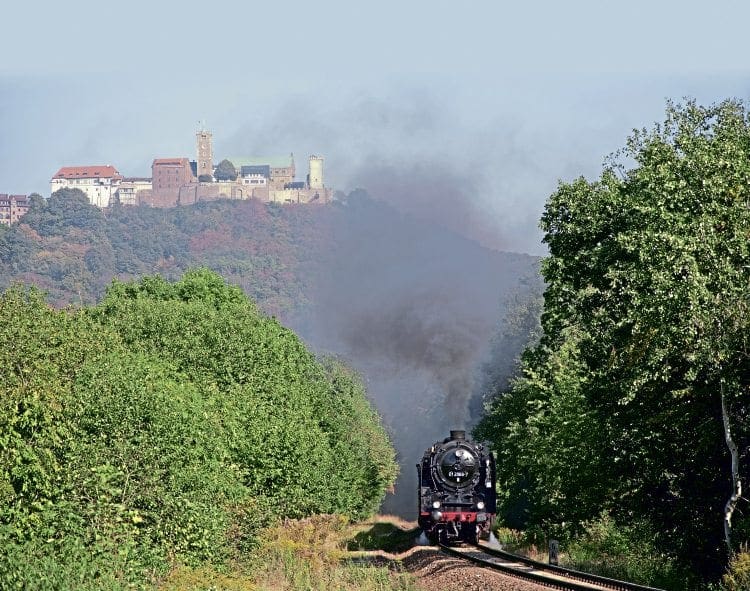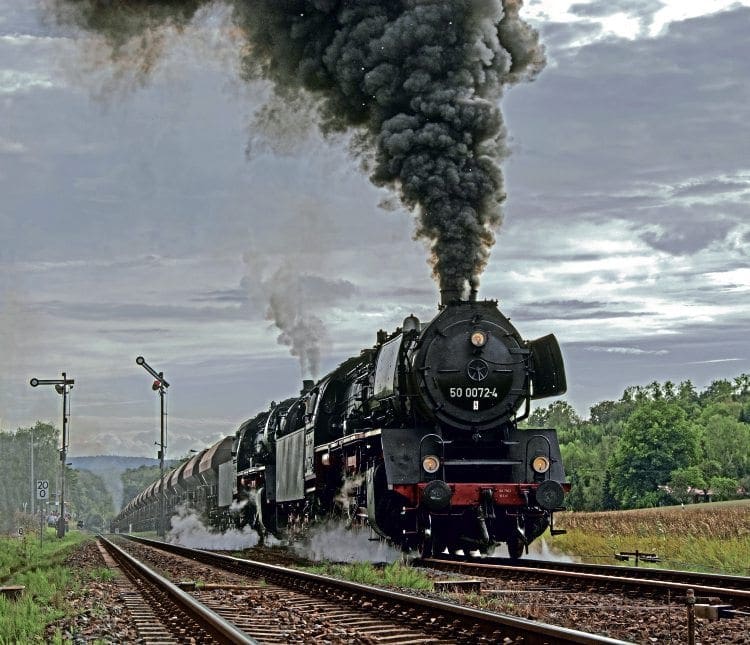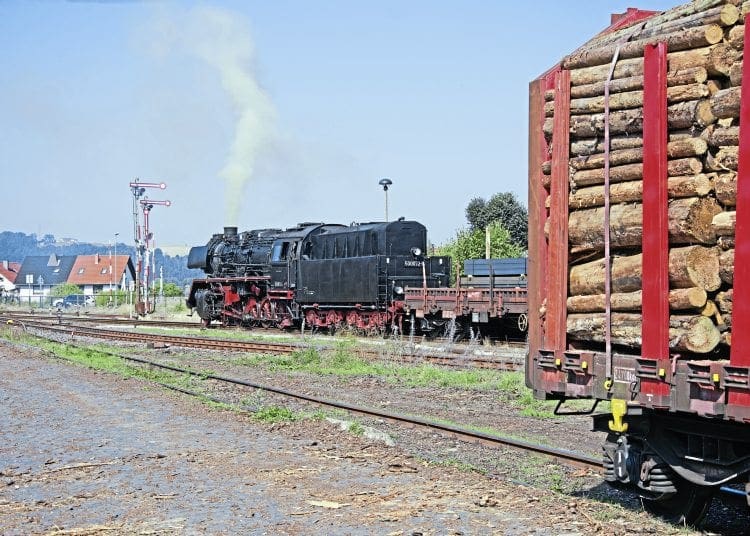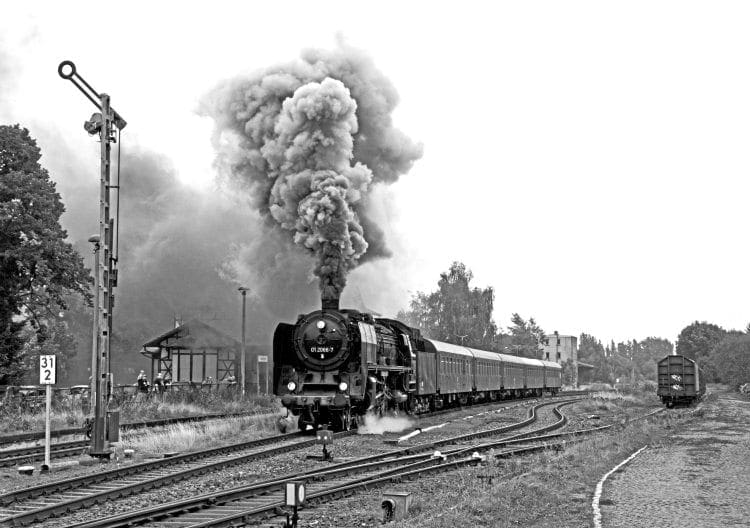For three days in September, steam locomotives were given responsibility for heavy goods trains in Germany, including a 550-ton steel train bound for the French capital. Plandampf is alive again, but for how much longer?
WORDS AND PHOTOGRAPHY: NICK BRODRICK
“Here I stand, I can do no other.”
Those were the immortal, defiant words of Papal rebel Martin Luther, who was sheltered in the iconic Wartburg castle, Thuringia, Germany, between 1521 and 1522, as his Protestant revolution began to grip central Europe.
Monthly Subscription: Enjoy more Railway Magazine reading each month with free delivery to you door, and access to over 100 years in the archive, all for just £5.35 per month.
Click here to subscribe & save
His most famous quotation came to mind, half a millennium later, stood as I was, on September 15, in the shadow of the monumental structures that make-up the 1067-built Wartburg, together with a mass of railway photographers, who were greeted by a crescendo of noise being emitted from an ‘01’ Prussian Pacific as it roared to the top of the 1-in-50 climb to Förtha tunnel.

It was one of those memorable moments that had lured around 250 enthusiasts, including many from Britain, to dig deep into their pockets (some £300 each) in order to put some of the sparkle – and grit – back into the former East German, Deutsche Reichsbahn on lines that are traditionally the dominion of diesels.
Where else on earth would hardened ‘gricers’ rather be? With 22 loco-hauled main line trains to ‘go at’, steam enthusiasts can ‘do no other’…
‘Timetabled steam’
The September 15-17 showcase was one of increasingly few Plandampfs that, if only fleetingly, turn back the clock from the modern day Deutche Bahn network to the era of the ‘Iron Curtain’, allowing commercial freight trains to be handed over to steam haulage.
Plandampf literally translates into English as ‘timetabled steam’.
In this instance, it was the opportunity to hook 10-coupled, two-cylinder locomotives onto the front of wagons laden with steel bound for a construction project in Paris that was the catalyst for the IGE Werrabahn-organised three-day event. The steel would be transported over the 60-mile ‘dog-leg’ route from Arnstadt, through the forests, valleys, small towns and villages of Zella-Mehlis, Schmalkalden and Bad Salzungen to Eisenach – a well-trodden route for steam on the annual winter ‘Rodelblitz’ tourist trains.
Climbs to the skiing attraction of Oberhof and Förtha are both a challenge for crews and a delight for linesiders.

The glory of the 550-ton spectacle was sadly diminished by fire-risk, which denied coal-burning class ‘50’ 2-10-0 No. 50-3501-9 its place at the business-end of the planned double-header with oil-fired classmate
No. 50 0072-4, meaning that ‘V 100’ class diesel No. 100 108-8 was attached to the rear of the seven-wagon train as insurance.
The deceptively heavy train took more than seven hours to reach Eisenach, while ‘01’ No. 01 2066-7 threaded through the scenic Werra valley with a five-coach photographic addendum, which gave little cause for concern of errant sparks igniting the tinder-dry lineside.
Its southern destination was Meiningen; familiar to British preservation followers as the town that gave new-build ‘A1’ No. 60163 Tornado its all-welded, steel boiler in 2006.
Damp, cooler conditions enabled the Werratal-based event to really get underway on September 16 as two more ‘50s’ joined the party. Conventional Class 50s’ Nos. 50 3648-8 and 50 3501-9 were pressed into action on a mix of genuine and photo-goods extras on a timetable that afforded hundreds of miles of intensive steam over the next 48 hours.

Intertwined with a smattering of steam-era level crossing barriers, upper-quadrant semaphore signals and ‘boxes, this central area of Germany was, in some respects, firmly back in the 1970s as the four black-and-red trim engines hammered to and fro. A few archetypal Trabants and, fittingly, Wartburg motor cars only heightened the sense of reminiscence for natives, and indeed some of the Brits who’d braved the German Democratic Republic’s rule of paranoid suspicion in order to experience such sights after the cessation of British Railways standard gauge steam in 1968.
Tremendous noise
The undoubted highlight of September’s Plandampf was a 2,100 ton, third-of-a-mile long, loaded gravel train, consisting of 25 bogie hoppers, which commanded the muscle of all three attending 2-10-0s to collectively lift them from Immelborn to Eisenach, involving 15 miles of ‘against-the-collar’ ascent, climaxing at the southern portal of Förtha tunnel to a tremendous noise.
It was, almost certainly, the heaviest steam-hauled freight to be seen anywhere in Europe – if not the world.
September’s ‘Stahl fur Paris’ is already some way short of the huge Plandampf extravaganzas of the 1990s, when around a dozen locomotives would be employed on expresses and overnight inter-cities, as well as goods workings.

Yet, as the fires of steam – particularly standard gauge – are doused down across the globe, the Plandampf concept is an increasingly important ideal together with surviving remnants in Bosnia and Poland. However, as more and more turntables and water cranes become de-rooted, and timetabled trains ever accelerated, the future for even semi-artificial steam is still endangered.
Almost 600 years ago, Martin Luther found safety in Thuringia. Today, refuge is sought for ‘real’ steam in the ‘green heart of Germany’. ■
The Railway Magazine Archive
Access to The Railway Magazine digital archive online, on your computer, tablet, and smartphone. The archive is now complete – with 120 years of back issues available, that’s 140,000 pages of your favourite rail news magazine.
The archive is available to subscribers of The Railway Magazine, and can be purchased as an add-on for just £24 per year. Existing subscribers should click the Add Archive button above, or call 01507 529529 – you will need your subscription details to hand. Follow @railwayarchive on Twitter.




